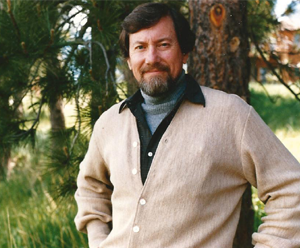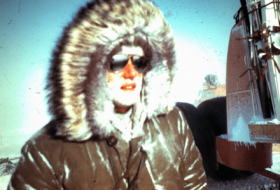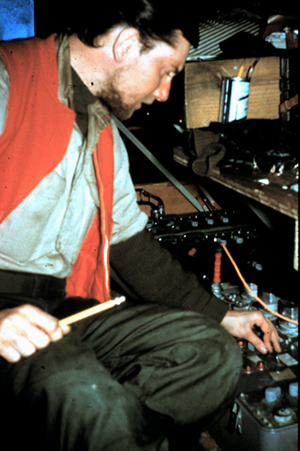Five questions for John Weihaupt
In 1959, John (Jack) Weihaupt and seven other scientists set out to explore uncharted areas of East Antarctica. The four-month journey, commissioned by the National Science Foundation, was fraught with danger and discovery.
Weihaupt, now an emeritus professor at the University of Colorado Denver, was the team’s seismologist, and he and his colleague, Frans G. Van der Hoeven, were responsible for the seismic, gravity, magnetic and geological surveys during the exploration. Part of his work included gathering data to determine the thickness of the ice; core samples led to the first scientific evidence for Earth’s contemporary global warming. Weihaupt and Van der Hoeven also were credited with the discovery of the Wilkes Land Gravity Anomaly, which potentially is the largest meteorite impact crater on the planet.
Using the team’s field notes and personal journals, Weihaupt has written a book that re-creates the Victoria Land Traverse, allowing readers to follow along with the researchers and the challenges they encountered. “Impossible Journey: The Story of the Victoria Land Traverse 1959-1960, Antarctica” has been published by the Geological Society of America (GSA) in Boulder. (Visit http://rock.geosociety.org/Bookstore/default.asp?catID=9&pID=SPE488 to purchase the book.)
The Victoria Land Traverse has been described as a major scientific and historic accomplishment and has been compared to the exploits of Capt. Robert Falcon Scott, Sir Ernest Shackleton and Sir Douglas Mawson.
In an introduction to the publication, Weihaupt and colleagues write: “No human endeavor is more fascinating than exploration, whether of Earth’s oceans, its highest mountains, or the polar high plateau. There is a need, primeval as it surely is, to go where no one’s gone before -- to be the very first.”
1. What is your background, and how did you come to CU?
I’m a small-town -- LaCrosse, Wisc. -- boy. My father had been an officer in World War I and my mother, Miss Wisconsin of 1927, was a beautiful woman of character. My younger brother, Dave, and I were youngsters who romped daily with nature, scouring the river bottoms and the bluffs around our river valley home. We became young adventurers, peering into forest margins and learning of the strange behaviors of the critters there. Then the Depression came and Dad lost everything. He died soon after. As teenagers, Dave and I worked to get enough money to go to college. I worked in the paper mill on the loading dock and as a stevedore when I was 17. When it was time to get an education, I went to the University of Wisconsin. I learned a lot, although the answers I got often differed from the ones I’d gotten in the river bottoms. Humans, it seems, assembled their ideas a little differently from those of our forest cousins on the wind.
After graduation, I joined the Army -- the 3rd Combat Engineer Battalion of the 24th Infantry Division in Korea -- where I learned about the canon’s haze and stuff like that. When I got out, I worked in the copper mines in South America to get a down payment on a home for our mother. Then I was recruited by National Science Foundation to go to Antarctica to do geophysics and geology. After that I got my doctorate. Next I became a professor, a department chair, an assistant dean, an associate dean, a dean, an associate vice President, a vice president, then a vice chancellor and then a professor. That’s what led me to CU.
2. Why did you choose to write “Impossible Journey” now? What are some of the contributions that resulted from the adventure?
After getting my doctorate, it seemed the right thing to do was to work at a university, so I did some professoring. I spent a lot of years in administration before I was able to get back to my research. When I did get back to research and writing, I and my Antarctic team members, many who were at other universities, were amused and a little concerned that our young 21st-century scientific successors were seemingly unaware of the contributions before them, claiming to have been the first (when they weren’t), and describing their airborne efforts as “daunting, dangerous and challenging.” They lamented the hardships of going inland in Antarctica on helicopters to do their daily field work, while returning to base for a hot meal and a cozy bunk.
Our journey was a four-month, 2,400-kilometer, overland journey in three Tucker SnoCats that went into the deep hinterland of East Antarctica where we were disconnected from humanity. We thought it prudent to fill in the blanks -- the historic and scientific blanks. I wrote “Impossible Journey” with contributions from my teammates. The book was just published by the Geological Society of America as the Society’s Special Publication 488, and we think it does a pretty good job of filling in the 20th-century history of Antarctic exploration.
It describes the discovery of the Wilkes Land Gravity Anomaly, and the discovery of the 400-by-1200-kilometer Wilkes Subglacial Basin by me and my colleague, Frans Van der Hoeven of The Netherlands. Also included is my team’s discovery of the Outback Nunataks, the USARP Mountain Range, and the upper reaches of the 200-kilometer long Rennick Glacier. Frans and I were the first to determine the thickness of the continental ice sheet in the vicinity of Victoria Land, and we provided ice cores to another team member, Claude Lorius, enabling him to be the first to discover contemporary global warming. As a result, Claude is now a member of the French Academy of Sciences.
3. Did you ever fear for your lives?
As it turned out, the planners of the Victoria Land Traverse were unaware of the challenges our team would face. Early in the journey, it was necessary for us to ascend the Skelton Glacier from the Ross Ice Shelf in order to enter Victoria Land in East Antarctica. On the 110-kilometer journey up the Skelton, the weight of the SnoCats and the 5-ton sledges we towed collapsed unseen snow bridges over large crevasses, threatening an early end to our journey. Later, we encountered more immense crevasses and chaotic ice surface terrain near the Mertz and Ninnis glaciers where Sir Douglas Mawson lost two of his men with their dog teams, sleds and provisions. That region also threatened the end of our traverse. Soon after, we had to abandon one of our three SnoCats because of severe structural damage. When we discovered the USARP Mountains, we were instructed by NSF’s representatives to explore them and the intermountain glaciers. The remaining two SnoCats and sledges were very nearly lost, and we with them, in massive crevasses on the Rennick Glacier. This happened very late in the season as the Austral Summer was giving way to the Austral Winter. The sun was nearing the horizon for its six-month absence, and it became essential for the team to be evacuated by helicopter to a waiting ice breaker. But that proved to be impossible because of the intervening mountains we’d discovered. Because of the difficulty of getting a ski-plane to our position, the NAF McMurdo coastal base decided to abandon our team to the coming winter. A U.S. Navy R4D was loaded to airdrop provisions sufficient for the six-month winter, and the flight crew hoped we would be able to survive. You’ll have to read the book for details and the harrowing end of the story!
4. Are there any other achievements or research that you can share with us?
As a result of the Victoria Land Traverse, my team members and I have continued our research and writing. On a later trip to Antarctica, I managed to be the first to determine the thickness of the ice sheet at the South Pole in the days when we were trying to determine the volume of ice in Antarctica and, thus, the rise in global sea level if that ice should melt.
My interest in the extent of the continental ice sheet in Antarctic resulted in my discovery of the ancient Orontius Finaeus Map of 1532, which has changed the discovery date of the Antarctic continent by some three centuries. I’ve also managed, with my colleague Frans Van der Hoeven, to be the first to describe and delineate the distribution of the gravity field of the Antarctic continent and its offshore periphery. As a result of those efforts, Mount Weihaupt in Victoria Land was named for me by the National Science Foundation and the Advisory Committee on Antarctic Names. I am also the recipient of several medals: France’s Expéditions Polaires Françes Medal, the Antarctic Medal, the Madisonian Medal, and several military medals (Korean War). I am a Senior Fellow of the Geological Society of America (GSA) and a Fellow of the Explorers Club. Finally, I was also an Astronaut Candidate (Johnson Space Flight Center “Interviewee”) in the early years of NASA’S space program. So there have been some good things that have come out of the Victoria Land Traverse effort well after our return from Antarctica, and we continue our research and hope to make additional contributions soon.
5. What are some activities you enjoy during leisure time?
My wife and I enjoy the outdoors, travel and intellectual pursuits. We are known for our work in the Rocky Mountain timberland; we do a lot of fire mitigation, cutting down and trimming ponderosas. We have devoted a great deal of time, effort and resources to caring for our families. Our travel has been pretty extensive, e.g., Europe, China, India, the former Soviet Union and now Russia, Australia, South America and Alaska. I’m keenly interested in quantum physics, cosmology and Ice Age anthropology, and read regularly in these areas. But, mostly I keep myself very busy with my research, and with a long-held wish – to write literature! I work endlessly and enthusiastically at this, but do much better with research.





